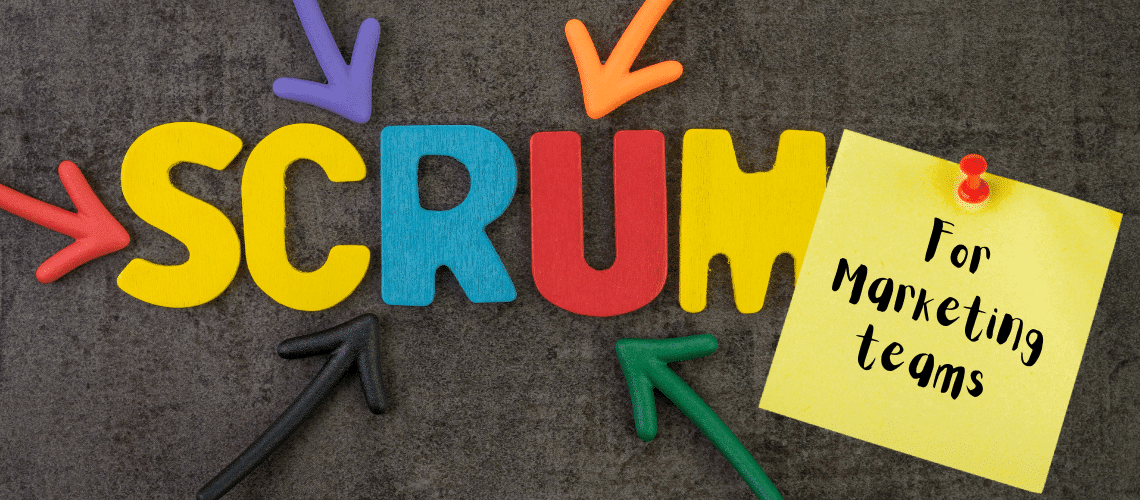Agile Marketing using Scrum: A Kick-start Guide
Scrum is an agile framework that can offer a structured approach to managing marketing campaigns and initiatives. It emphasizes collaboration, adaptability, and iterative progress. In Scrum, marketers work in short, time-boxed iterations called sprints, typically lasting 1-4 weeks.
Part 1: Backlog
n Agile Marketing using Scrum, the first crucial element to understand is the backlog. Essentially, the backlog is a prioritized to-do list that serves as the primary source of work for the marketing team. Although it sounds simple, maintaining an effective backlog can be surprisingly challenging.
To be truly valuable, the backlog requires constant updates and the work items at the top should have enough detail for the Agile marketing team to start working on them immediately, without needing to seek further clarification or guidance.
A well-maintained backlog is the cornerstone of a high-functioning Agile team, regardless of the domain. Neglecting it can lead to issues throughout the entire process.
Part 2: Sprint Backlog and Planning
At the beginning of each sprint, the marketing team selects work items from the comprehensive marketing backlog to form a smaller sprint backlog. This represents the amount of work they believe they can complete within the upcoming sprint. Importantly, this decision is made by the team itself, rather than being dictated by managers, directors, or the Chief Marketing Officer (CMO).
The rationale behind this approach is that the Agile team, being responsible for executing the work, possesses the best understanding of the actual time required for completion. They are, therefore, the most qualified to determine how much work they can realistically achieve in the following weeks.
The meeting where the team plans and decides on the sprint backlog is known as the Sprint Planning meeting. As a general guideline, it is recommended to allocate an hour for each week of the sprint when planning. For instance, a two-week sprint would typically require two hours of planning. During this meeting, the team may also estimate the relative size of the work items using a point-based system, often employing the Fibonacci sequence for assigning points. For example, a project with a size of 2 is considered twice as big as a project assigned a size of 1, and so on.
The total number of points the team commits to for the sprint is referred to as its Velocity. Ideally, this number should steadily increase over time as the team becomes more proficient and mature.
Estimating work items provides a more objective view of the team’s output, but it can be a contentious practice. Some argue that estimating is wasteful since humans are often unreliable at it, particularly when they are new to the practice. On the other hand, proponents of estimation emphasize that it is crucial for tracking a Scrum team’s progress over time. Additionally, estimation helps quantify the impact of interruptions or emergencies by enabling the team to demonstrate the difference in completed points when such disruptions occur.
Regarding estimation, it is recommended to try it out and evaluate its benefits for your team. Be honest about whether the time spent on estimation aligns with the desired outcomes, and adjust accordingly. It’s important to allocate sufficient time to the experiment, ideally a couple of months, as teams may need time to adapt and improve their estimation skills through practice.
Part 3: Sprint Execution
Once the Sprint Planning meeting concludes, the team commits to completing the agreed-upon work, and the sprint officially begins. Ideally, once the sprint is underway, no additional work should be added to the team’s workload. However, in reality, unplanned events may arise. In such cases, the team can negotiate by removing some work to accommodate the unexpected projects or leave some time unplanned, anticipating that it will be filled with unforeseen tasks.
During the sprint, the team convenes daily for the Daily Standup meeting, also known as the Daily Scrum. Each team member provides a brief update on their progress, discussing what they accomplished the previous day, what they plan to do that day, and any obstacles they are facing. To ensure efficiency, the
Daily Standup meeting should not exceed 15 minutes to avoid wasting valuable team time. It is helpful to conduct the meeting with all participants standing, as it encourages brevity and focus. Prohibiting the use of laptops and phones during the meeting also promotes concise discussions.
While the traditional format of the Daily Standup includes the three key updates mentioned earlier, it is essential to elevate the meeting beyond a mere check-in. The Daily Standup should be treated as a mini-strategy meeting or a football huddle, where all team members actively think about how they can collaborate and work together in the next 24 hours to optimize their progress. Just as a football team decides on the next play during a huddle, the team should strategize on the most effective approach for accomplishing their tasks.
As the sprint approaches its conclusion, the goal is to have deliverable work that can potentially be released to the target audience. While it is not mandatory to release a small component of a larger campaign, one of the strengths of Scrum is its ability to consistently deliver valuable marketing work to the audience throughout the process.
Part 4: Post-Sprint Meetings
At the end of the sprint, two important meetings take place: the Sprint Review and the Retrospective.
The Sprint Review is akin to a show-and-tell session. It involves the attendance of all relevant internal stakeholders who requested the work completed during the previous sprint. The marketing team showcases the deliverables and seeks feedback from these stakeholders. It is crucial to ensure that the Sprint Review includes the right audience beyond the Scrum team, as they have been intimately involved in the tasks and don’t require further internal presentation. Inviting stakeholders who can utilize the created work and provide valuable feedback is essential for the success of the Sprint Review.
The Retrospective meeting, on the other hand, is exclusive to the Scrum team. It provides an opportunity for the team members to openly discuss their experiences with the Scrum process and explore ways to enhance it. Any suggestions for improvement should be documented and added to the backlog to ensure they are addressed. Continuously discussing the same issues without taking action can be frustrating, so it is crucial to treat retrospectives as valuable meetings that drive positive change. To keep retrospectives fresh, it is recommended to appoint a facilitator to lead the meeting, encourage active participation from all contributors, foster respectful debates, and make these meetings a priority for the team.
Following the retrospective, the cycle starts anew with a Sprint Planning meeting to kick off the next sprint.
Part 5: Scrum Marketing Team Members
While traditional Scrum roles include a Scrum Master, a Product Owner (PO), and developers, marketing teams often have unique compositions.
In many cases, having a dedicated Scrum Master may not be feasible due to budget constraints. A practical solution is to have a few team members obtain Scrum Master certification and rotate the Scrum Master responsibilities among them, allowing them to continue performing their regular duties alongside their Scrum Master role. The Scrum Master‘s primary responsibility is to ensure the team’s adherence to Scrum practices, facilitate meetings, foster an Agile mindset, and provide suggestions for process improvement.
As for the Product Owner role, which serves as the intermediary between the development team and the business, marketing teams often find success when assigning these responsibilities to a marketing leader, such as a director or senior manager. It is not essential to formally change someone’s title to Product Owner; what matters is that they and the stakeholders understand their duties and responsibilities in fulfilling the Product Owner role.
Unlike Scrum’s original concept of a purely cross-functional team where everyone is a “developer,” marketing teams often consist of specialized individuals. There is no need to enforce a uniform “Marketer” title for all team members.
Part 6: Scrum Marketing Challenges and Considerations
Implementing Agile Marketing using Scrum brings its own set of challenges. It requires a mindset shift, adjustment of existing processes, and ongoing commitment from the entire marketing team. Here are a few considerations to keep in mind:
Management support: Ensure that the organization’s management understands and supports the transition to Agile Marketing. Leadership buy-in is crucial for providing necessary resources, encouraging cultural changes, and aligning the organization’s goals with the Agile approach.
Training and education: Invest in training programs and workshops to educate the marketing team on Agile methodologies, Scrum practices, and the principles of self-organization and collaboration.
Iterative improvement: Embrace the concept of continuous improvement and encourage the marketing team to reflect on their processes regularly. Actively address and resolve any impediments or challenges that arise.
Flexibility and adaptation: Agile Marketing allows for flexibility and adaptability. Embrace change and be open to adjusting plans and priorities as new information emerges or market conditions evolve.
Communication and transparency: Foster a culture of open communication and transparency within the marketing team. Encourage sharing ideas, concerns, and progress updates to enhance collaboration and trust.
Why choose Scrum for Marketing projects?
By adopting Scrum, marketers can increase their agility, streamline their workflows, and deliver marketing initiatives more efficiently. It provides a structured framework that helps marketers focus on high-priority tasks, collaborate effectively, and adapt their strategies in a rapidly changing marketing landscape.
Improved Flexibility: Scrum enables marketers to respond quickly to changing market conditions and customer feedback. By breaking work into manageable units (user stories) and prioritizing them in a backlog, marketers can adjust their plans easily, reprioritize tasks, and adapt their strategies based on real-time insights.
Enhanced Collaboration: Scrum promotes collaboration within marketing teams and fosters better alignment with other stakeholders, such as sales, product, and management. Daily Standup meetings allow team members to synchronize their efforts, share progress updates, and address any obstacles together. This ensures everyone is on the same page and helps build a cohesive and collaborative work environment.
Transparent Progress Tracking: Scrum provides clear visibility into the progress of marketing initiatives. Through the sprint backlog and burn-down charts, marketers can track completed tasks, remaining work, and overall project status. This transparency facilitates effective communication with stakeholders, allowing them to have a realistic understanding of what’s being worked on and when they can expect results.
Continuous Improvement: Scrum encourages teams to reflect on their processes and outcomes regularly. The Sprint Review and Retrospective meetings at the end of each sprint provide opportunities to evaluate the marketing work delivered, gather feedback, and identify areas for improvement. This iterative feedback loop allows marketers to refine their strategies, optimize workflows, and continually enhance their performance.
Empowered Decision-Making: Scrum empowers marketing teams by giving them ownership and autonomy over their work. Unlike traditional top-down management approaches, Scrum trusts the expertise and knowledge of the marketing team members. They have the authority to decide how much work they can commit to in each sprint, how to approach the tasks, and how to self-organize to deliver results effectively.
Remember, Agile Marketing using Scrum is not a one-size-fits-all solution. It may require experimentation, adaptation, and refinement to align with your specific marketing team’s needs and objectives.











